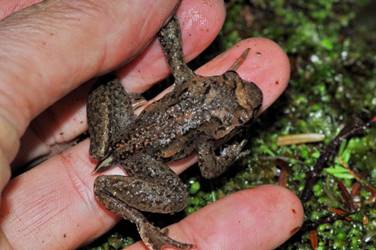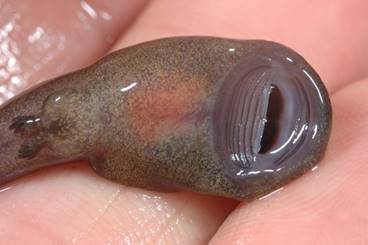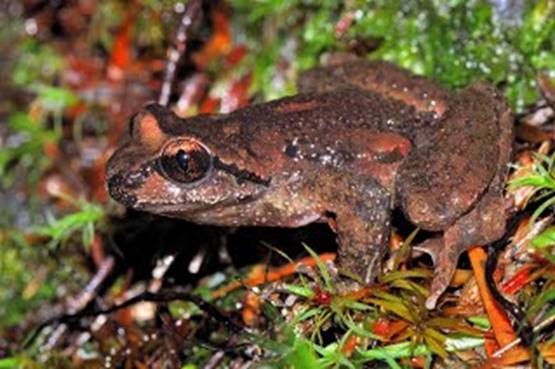Tailed frogs are interesting from a number of perspectives. They are the only species within the family Ascaphidae, the males have a small “tail” that is actually a part of the cloaca (common opening for waste/sperm), they lack the ability to vocalize, they have a greater number of vertebrate than other frogs, and they have free ribs. All of which appear to indicate a more ancient lineage. They also share some characteristics with the Leiopelma, a genus of primitive frogs in New Zealand. The prehistoric Vieralla also belongs in the tailed frog family.

In 2001 the tailed frog was split into two species – the coastal species found in WA, OR, northern CA and in southeastern BC; and the Rocky Mountain species found in southeastern BC (Rockies), Idaho, Montana, and the Wallowa Mountains of southeastern WA. They have been found at near sea level and up to 8.400 ft. elevation.
These frogs are small – only 1-2 inches in length. They are kind of flat, with rough skin and a vertical pupil. Their fingertips are hardened into little claws that help them crawl on rocks on the stream bottom. Their lungs are reduced in size to decrease buoyance and respiration takes place mainly through the skin.
The skin color matches the rocks of the inhabited stream, usually olive, brown, gray or reddish on the back with yellow or gray mottling. There is a pale yellow or greenish triangle on the snout with a noticeable dark eye stripe. Males are a bit smaller than females and sport the distinctive tail.
Tailed frogs inhabit fast moving, permanent, cold, clear mountain streams in wet forests. They do not inhabit ponds or lakes and a rocky streambed is necessary for protective cover for adults, eggs, and larvae. After heavy rains adults may be fund in the woods away from the streams. They have been found in areas without trees following the eruption of Mt. St. Helens.
So living in a fast flowing world requires some special adaptations – thus the tail of the tailed frog. Most frogs and toads have external fertilization – the female lays eggs while clasped from behind by the male who releases his sperm, and fertilization takes placed in the water of a pond or lake edge. But if a tailed frog used this method everything would quickly get washed downstream.
The male frog uses his tail to guide sperm into the female cloaca and fertilization takes place internally. Copulation may last 24-36 hours and the female will store the sperm for up to two months prior to fertilization. Tailed frogs are the only genus to have internal fertilization. So many folks – ok, frog nerd folks – travel from around the world to get a glimpse of our tailed frog.
Breeding typically occurs in late spring or summer following the high flow of snow melt. During the breeding season males develop black, horny tubercles on each forefoot and forearm, which help hold the female during mating. It is not clear how males attract mates because they do not have vocal sacs for calling. It is so noisy along a stream corridor that this capacity was lost because of its limited usefulness. There is some speculation that males and females meet using chemical signals.
The adults are mostly nocturnal and emerge at night to forage on rocks, though occasionally they can be found moving around during the day. They are active from April to October. To escape predators, they will jump into the water and be carried downstream. Adults and juveniles eat a wide variety of invertebrates, basically whatever is in season.
The female lays 40 or so fertilized eggs under large rocks and the tadpoles hatch in 3-6 weeks. It will take one to two years for the tadpoles to metamorphose into frogs for coastal populations and depending on elevation can take up to develop into adults. The colder the stream and the shorter the summer, the longer it takes to get to adulthood.
As a tadpole in this environment there is always the threat of being washed downstream and these small animals have developed a unique solution. The tadpoles feed on algae on rocks and boulders and have a strong sucker mouth that they use to cling to the rock surface. They have been found to forage on diatoms, algae, desmids, and conifer pollen. You can often see them just above the water line munching away, but they are shy and will drop off the rock, often before you can spot them. I knew a tailed frog researcher who would conduct her tadpole surveys using binoculars to get an accurate count while not disturbing the little guys.

Ascaphus: – Greek for without, and Greek: skaphis spade – notes the lack of a metatarsal spade; truei: – honors True, Frederick W. True, an American naturalist and the first director of the United States National Museum, which became the Smithsonian Institution. He started his biology career as an invertebrate biologist but gave up that field because of eyesight problems that made it difficult to use a microscope. So off to study bigger things. He also is honored in the Latin names for True’s beaked whale and True’s shrew mole, which has a ring to it.

I’ve only seen these frogs a handful of times, though I often when I’m up in the mountains. The last time I came across some was after trudging down from Gothic Basin in the Monte Cristo Range of WA. The trail paralleled a creek for about 2,000 ft. in elevation and dumped into the Sauk River. I waited for my friends, took off the big pack, and started doodling around at the stream edge.
Right at the confluence where the gradient flattened I found about 20 tailed frog tadpoles in the clear, cold water. They were all happily munching away on the rocks in about 6 inches of water and I was happy just to idle away my time while waiting for my companions. We took a break for a snack as well before heading back to the car on the old Monte Cristo mining road.
